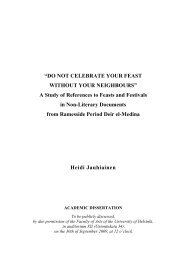BIA
bia51
bia51
Create successful ePaper yourself
Turn your PDF publications into a flip-book with our unique Google optimized e-Paper software.
AVRIL 2015<br />
scene and its discovery, in order to do more<br />
than simply feed speculation, he said.<br />
“We should not think about doing more<br />
studies to accept or refute the ideas of the<br />
Italian researcher because this way we would<br />
open the door to discrediting the great<br />
civilisation of ancient Egypt,” Migâhid<br />
concluded.<br />
Former minister of antiquities Zâhî Hawwâs<br />
described TIRADRITTI’s claims as “unfounded,”<br />
accusing him of breaking the antiquities law<br />
and the ministry’s regulations, which stipulate<br />
that any new discovery or research should first<br />
be presented to the ministry and its permanent<br />
committee for approval before being published.<br />
TIRADRITTI published his theory in Live Science<br />
without doing this, he said.<br />
“He must be penalised for not following the<br />
rules, and the permanent committee could now<br />
stop his mission from resuming its<br />
archaeological work in Luxor,” Hawwâs said,<br />
who added that during his tenure as minister<br />
he had taken action against several foreign<br />
missions for breaking the ministry’s regulations.<br />
(Nevine El-Aref, “Controversy over the Maydûm<br />
Geese”, Al-Ahram Weekly, April 9, 2015. Voir<br />
également Ahmad Mansûr, « Le président du<br />
département des musées : La stèle de Maydûm<br />
est authentique. La mettre en doute porte<br />
atteinte à notre patrimoine », al-Yawm al-Sâbi‘,<br />
2 avril ; « Étude italienne : la stèle des oies<br />
de Maydûm conservée au Musée Égyptien est<br />
un faux », al-Shurûq, 3 avril ; Muhammad<br />
Mansûr, « Rapport de la mission italienne : la<br />
Joconde égyptienne n’est pas authentique »,<br />
al-Masrî al-Yawm, 7 avril ; “Italian<br />
archaeologists: Ancient Egyptian ‘Mona Lisa’<br />
fake”, Egypt Independent, April 7).<br />
- -<br />
It is very strange that these days we<br />
sometimes hear people appear suddenly to talk<br />
nonsense about famous objects in the Egyptian<br />
Museum.<br />
We have heard stories about the golden<br />
mask of Tutankhamun, for example, with some<br />
people claiming it is a fake. This of course is<br />
completely false.<br />
More recently, an archaeologist from Italy,<br />
Francisco TIRADRITTI, who has been excavating<br />
and restoring tomb TT37 in Herwa near Thebes<br />
on the west bank of the Nile, told the<br />
publication Live Science that “Egypt’s Mona Lisa<br />
may be fake,” in reference to the ancient<br />
Egyptian painting of the Maydûm Geese.<br />
The announcement is strange because<br />
TIRADRITTI is working in Egypt and he knows the<br />
law which states that any announcement or<br />
discovery has to be submitted first to the head<br />
of the antiquities department before it can be<br />
made public.<br />
I do not understand why TIRADRITTI said what<br />
he did without giving prior warning to the<br />
Ministry of Antiquities, instead of which he said<br />
the painting “may be fake.” Moreover, TIRADRITTI<br />
is an archaeologist and not an art historian,<br />
and therefore what he says about art should<br />
be questioned.<br />
The painting of the Maydûm Geese was<br />
found in 1871 in the tomb-chapel of Atet, or<br />
Itet, the wife of Prince Nefermaat, who was the<br />
son of the Fourth Dynasty pharaoh Senefru.<br />
The latter is believed to have ruled Egypt for<br />
54 years and built four pyramids at Sila-<br />
Maydûm and two in the Dahshûr Necropolis.<br />
The first two pyramids were built as step<br />
pyramids, but at the end of his reign Senefru<br />
completed a true pyramid. The tomb of<br />
Nefermaat and Atet was built beside Senefru’s<br />
pyramid at Maydûm, and the painting of the<br />
Maydûm Geese was found by an Italian artist<br />
called Luigi VASSALLI who took the painting from<br />
the tomb to the Egyptian Museum.<br />
In his interview, TIRADRITTI said that he had<br />
studied the painting for several months, and<br />
that he believed another painting could be<br />
hidden underneath the painting in the museum.<br />
However, if this were true this second painting<br />
could easily be detected using the new<br />
technology.<br />
TIRADRITTI claimed that the geese shown in<br />
the painting were not known in Egypt at the<br />
time, with one of them, the bean goose, being<br />
from northern Spain, Greece and Turkey, and<br />
the other, the red-breasted goose, being from<br />
the Aegean coast of Greece and Turkey.<br />
TIRADRITTI also said that the colours used in<br />
the painting, beige and mauve, were not used<br />
in ancient Egypt. I do not fully understand what<br />
<strong>BIA</strong> LI — Janvier/Juin 2015 85



